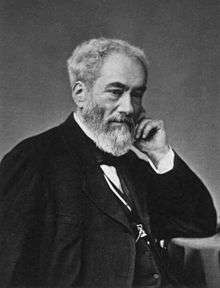Robley Dunglison
Robley Dunglison (4 January 1798 – 1 April 1869) was an English physician who moved to America to join the first faculty of the University of Virginia.
Robley Dunglison | |
|---|---|
 | |
| Born | 4 January 1798 |
| Died | 1 April 1869 (aged 71) Philadelphia, Pennsylvania |
| Burial place | Laurel Hill Cemetery |
| Occupation | Physician |
| Spouse(s) | Harriette Leadam |
He was personal physician to Thomas Jefferson and considered the "Father of American Physiology".[1][2]
Biography
Robley Dunglison was born in Keswick, Cumbria, England. He studied medicine in London, Edinburgh, and Paris. He obtained his M. D. from the University of Erlangen, Germany, in 1823 [3]
In 1824, Thomas Jefferson and the Board of Visitors of the University of Virginia commissioned Francis Walker Gilmer to find professors in England for his new University. Gilmer offered the anatomy and medicine professorship to Dunglison.[4]
While at UVA, Dunglison published his landmark text Human Physiology (1832), which established his reputation as the “Father of American Physiology.” [5] A dormitory at UVA has been named in honor of Dunglison.[6]
In 1832, Dunglison moved to the University of Maryland. Three years later Dunglison became Chair of the Institutes of Medicine and Medical Jurisprudence at the Jefferson Medical College (JMC) in Philadelphia, where he spent the rest of his career.
Marriage and children

Dunglison's offer to become professor of anatomy and medicine at the University of Virginia allowed him to marry Miss Harriette Leadam, whom he had been courting.[7] They were married 4 October 1824, and left England for Virginia at the end of month. They had seven children:[8]
- Harriette Elizabeth (1825 – 1841)
- John Robley (1826 – ?)
- a son, born in 1828, died of bronchitis at 11 months
- William Leadam (1832 – ?)
- Richard James (1834 – 1901) -- earned MD at JMC in 1856; editor of First American Edition of Gray's Anatomy in 1859[9]
- Thomas Randolph (1837 – ?)
- Emma Mary (1840 – ?)
Huntington's Disease
One of Dunglison's recently graduated students at Jefferson Medical College, Charles Oscar Waters, provided his professor with a description of the "magrums" (a folk name for what is now called Huntington's disease), which Waters knew from his travels in Westchester County, New York.
Although he had never seen a case, Dunglison included a description of the disease in his 1842 textbook The Practice of Medicine. Waters's account of the disease was one of the first to note that the disease is hereditary, "within the third generation at farthest."
Another of Dunglison's students at Jefferson, Charles R. Gorman, wrote his thesis on the magrums as well.[10]
Works
Published works
- 1824 Commentaries on Diseases of the Stomach and Bowels of Children
- 1832 Human Physiology
- 1833 A New Dictionary of Medical Science and Literature. The 2nd (1839), 3rd (1842), and 5th (1845) editions added "Medical Lexicon" to the title page.
- 1837 The Medical Student; or, Aids to the Study of Medicine
- 1846 New Remedies. 5th edition.
- 1874 A Dictionary of Medical Science.
Notes
- Topper, Joby (2005). [http://www.hsl.virginia.edu/historical/uva_hospital/dunglison/index.cfm Profile: University of Virginia, Professor and Physician: Robley Dunglison, M.D.], Virginia.edu; accessed 13 November 2017.
- ROBLEY DUNGLISON profile (1798–1869), collphyphil.org; accessed 13 November 2017.
- Radbill, Samuel X., ed. (1963) The Autobiographical Ana of Robley Dunglison, M.D. American Philosophical Society.
- Bruce, Philip Alexander (1921). History of the University of Virginia: The Lengthening Shadow of One Man. I. New York: Macmillan. pp. 342, 371.
- The National cyclopaedia of American Biography. 10. New York: James T. White and Co. 1909. p. 270.
- https://housing.virginia.edu/area/1201
- Hickman, Ellen C. "Dunglison, Robley (1798–1869)". Encyclopedia Virginia. Retrieved 4 May 2016.
- Radbill, pp. 4–9
- Gray's Anatomy: The Jefferson Years
- Wexler, Alice; Nancy Wexler (2008). The Woman Who Walked Into the Sea. Huntington's and the Making of a Genetic Disease. Yale University Press. p. 288. ISBN 978-0-300-10502-5.
References
- Dorsey, John M., ed. (1960) The Jefferson-Dunglison Letters. Charlottesville: University Press of Virginia.
External links
| Wikimedia Commons has media related to Robley Dunglison. |
- Flanagan, Dan (1996). Robley Dunglison Collection. Thomas Jefferson University: Philadelphia
- The Microscope of Robley Dunglison. Made by James Smith, London in 1845